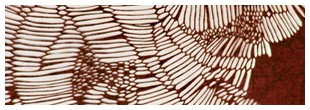|
|
|
|||||||||||||||
| |
||||||||||||||||
|
The MONYOU in my head transfers itself into maps, streams of rivers and even into elements of air. In my imagination, I sometime look up at the columnar joint and I am fascinated by the HUUMON, the wind-wrought pattern on the sand hill, by the desert or by the workrooms of the Rinpa artists and of the UKIYOE painters in the EDO Era. In this way, MONYOU makes me travel all over the world and see Emile Galle?, too. The world around me changed completely when I was moved by the pleasure. I struggled to take the whirling thoughts of MONYOU out of my head and to find out the best way to grasp it which only I can see. And at last, I reached the improvisation by cutting. The Japanese word SOUSAKU means “creation” and it also means to cut materials by a knife. I cut WASHI by a designing cutter, aiming at a new creation of my own MONYOU by cutting. Then, I will explain about the reason I stick to WASHI. I have once worn an overcoat of WASHI, which was a blue and gray one of crumpled WASHI coated with Persimmon Tannin Juice. I will never forget the warmth of the coat beyond description at the time I wore. It was too light for me to be conscious of wearing, but it gave me some comfort of being held tight. I gave up getting it, because it was the only one of its kind extant and very expensive. But since then WASHI became indispensable for me. Strangely, when I touch WASHI, I feel so comfortable that I can go to another world even when I am annoyed with daily troubles. It seems to me that MONYOU has such power as it exists sometime beyond time and sometime beyond space. Drawing takes much time rather than cutting. I can embody my imagination by dyeing and cutting WASHI as I like. This unique way of expression suits to my motif and thought best. More than 1500 years ago, MONYOU was brought through the Silk Road over to Japan in the east end of the Eurasian Continent. The MONYOU, which came to Japan with Buddhist arts, developed independently in the climate peculiar to Japan. And it has been still fascinating the European painters and craft men as the Japonisme. There are now many European artists who follow their style assimilating the Japonisme like their own. This is the very evidence that MONYOU has supported its pendulum movement of the fertile culture on the stage of the Eurasian Continent. So it is one cultural ambassador living beyond the ages. I myself, who live far in the east of the Eurasian Continent, have a desire to carry a part of abstract expression by MONYOU. And I named this original world of mine "Eurasian Choko Craft". Nobuo Tsuji, a scholar of art history, has mentioned "play, decoration and Animism" as the Japanese characteristic arts. And Shizuka Shirakawa, a scholar of Chinese characters, has said that "play is the world of an absolute freedom and of full of creation". MONYOU continues developing as a means of expressing human original desire for decoration. I was once calmly impressed when I knew that Augusto Giacometti, who learned the decoration art, painted a colorful abstract image. Now intuition, MONYOU which only I can see, drives me to the world of abstract expression, looking for much more development of the "Eurasian Choko Craft". Back to menu copyright 2022 中ぞの蝶子 Original Arts exclusive from Choko Nakazono Arts Studio. since 1st may 2007 |
|
||||||||||||||
|
|
||||||||||||||||
